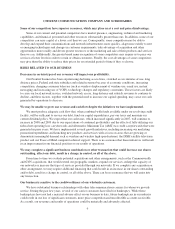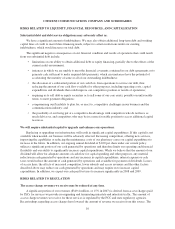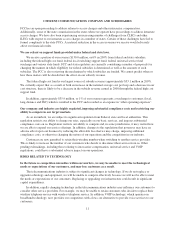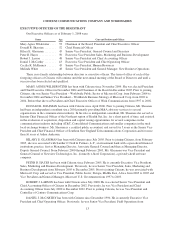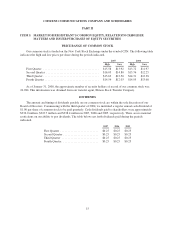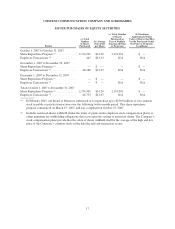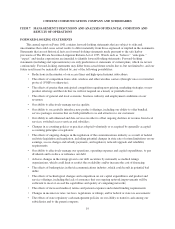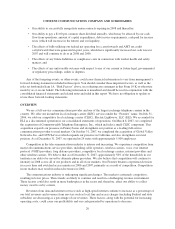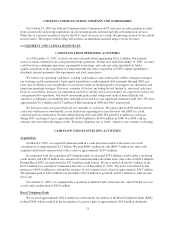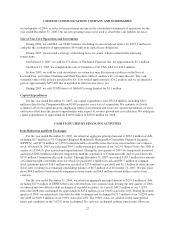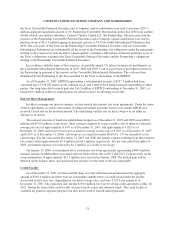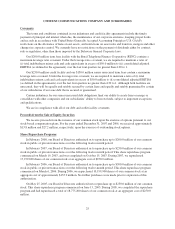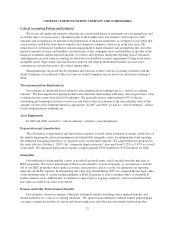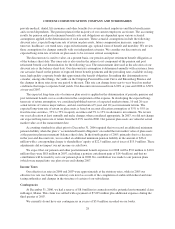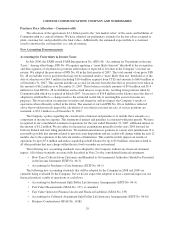Frontier Communications 2007 Annual Report Download - page 23
Download and view the complete annual report
Please find page 23 of the 2007 Frontier Communications annual report below. You can navigate through the pages in the report by either clicking on the pages listed below, or by using the keyword search tool below to find specific information within the annual report.CITIZENS COMMUNICATIONS COMPANY AND SUBSIDIARIES
ITEM 7. MANAGEMENT’S DISCUSSION AND ANALYSIS OF FINANCIAL CONDITION AND
RESULTS OF OPERATIONS
FORWARD-LOOKING STATEMENTS
This annual report on Form 10-K contains forward-looking statements that are subject to risks and
uncertainties that could cause actual results to differ materially from those expressed or implied in the statements.
Statements that are not historical facts are forward-looking statements made pursuant to the safe harbor
provisions of The Private Securities Litigation Reform Act of 1995. Words such as “believe,” “anticipate,”
“expect” and similar expressions are intended to identify forward-looking statements. Forward-looking
statements (including oral representations) are only predictions or statements of current plans, which we review
continuously. Forward-looking statements may differ from actual future results due to, but not limited to, and our
future results may be materially affected by, any of the following possibilities:
• Reductions in the number of our access lines and high-speed internet subscribers;
• The effects of competition from cable, wireless and other wireline carriers (through voice over internet
protocol (VOIP) or otherwise);
• The effects of greater than anticipated competition requiring new pricing, marketing strategies or new
product offerings and the risk that we will not respond on a timely or profitable basis;
• The effects of general and local economic, business, industry and employment conditions on our
revenues;
• Our ability to effectively manage service quality;
• Our ability to successfully introduce new product offerings, including our ability to offer bundled
service packages on terms that are both profitable to us and attractive to our customers;
• Our ability to sell enhanced and data services in order to offset ongoing declines in revenue from local
services, switched access services and subsidies;
• Changes in accounting policies or practices adopted voluntarily or as required by generally accepted
accounting principles or regulators;
• The effects of ongoing changes in the regulation of the communications industry as a result of federal
and state legislation and regulation, including potential changes in state rate of return limitations on our
earnings, access charges and subsidy payments, and regulatory network upgrade and reliability
requirements;
• Our ability to effectively manage our operations, operating expenses and capital expenditures, to pay
dividends and to reduce or refinance our debt;
• Adverse changes in the ratings given to our debt securities by nationally accredited ratings
organizations, which could limit or restrict the availability and/or increase the cost of financing;
• The effects of bankruptcies in the telecommunications industry, which could result in potential bad
debts;
• The effects of technological changes and competition on our capital expenditures and product and
service offerings, including the lack of assurance that our ongoing network improvements will be
sufficient to meet or exceed the capabilities and quality of competing networks;
• The effects of increased medical, retiree and pension expenses and related funding requirements;
• Changes in income tax rates, tax laws, regulations or rulings, and/or federal or state tax assessments;
• The effects of state regulatory cash management policies on our ability to transfer cash among our
subsidiaries and to the parent company;
19


